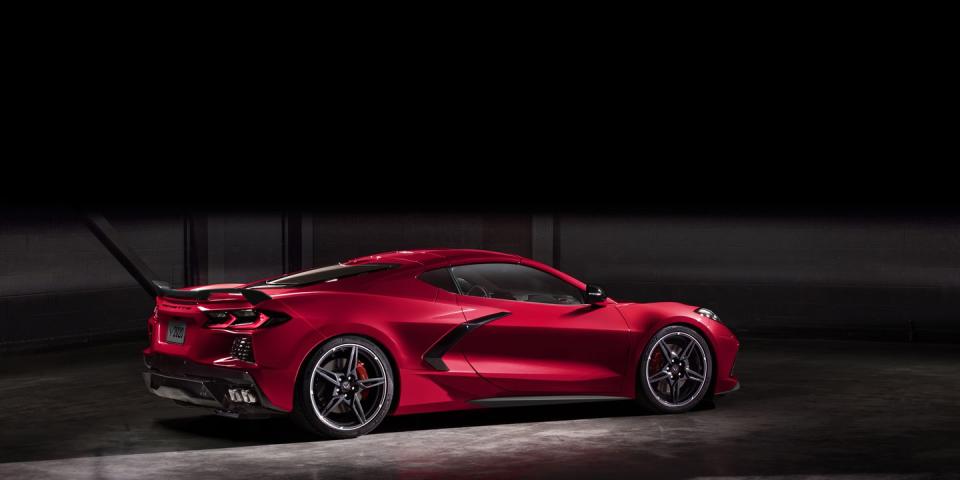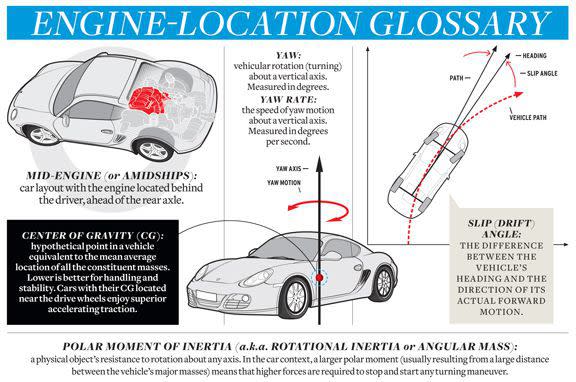Confused by the Mid-Engined Chevy C8 Corvette? Here's What "Mid-Engined" Means and Why It Matters

Read everything we have to say about the mid-engined 2020 Chevy Corvette.
Since its inception, the Chevrolet Corvette—in production form, at least—has never deviated from three core attributes: front engine, rear-wheel drive, fiberglass bodywork. From its 1953 debut with the Blue Flame inline six-cylinder to the thundering 755-hp 2019 Corvette ZR1, the basic formula has been set in stone.
That all changes now. With the introduction of the C8 Chevy has officially moved the engine to the middle, behind the passenger seats.
With this move, Chevrolet is shooting a flare into international waters, putting on notice the major players in the mid-engine-performance space including the Ferrari 488, Lamborghini Huracán, and Audi R8 as well as its crosstown rival, the Ford GT, and letting them know that the General can still cut and run when the accountants provide a long enough leash.
To get a little insight on why Chevrolet decided the time had come to officially join the mid-engine club (after decades of rumors, concepts, and stillborn efforts), we turned to Tadge Juechter, Corvette chief engineer, for the inside story.
Juechter told us that although GM has alluded to a mid-engined production Corvette for decades, its true genesis occurred during the final development of the sixth-generation ZR1. "We knew we were in trouble way back in the [sixth] generation when we started doing a ZR1. We had a 638-horsepower engine and it wasn’t until the eve of production—and only because of the super-sticky Michelin tires—that were were quicker from zero-to-60 than the 505-hp Z06. So, we had aspirations for higher performance, but we were reaching the limit of the architecture."
So what does "mid-engined" mean? Technically, it means that a car's engine is located in the middle of the vehicle, somewhere between the front and rear axles. But the typical location in a sports car or supercar is behind the driver and in front of the rear axle.

Engine placement matters for many reasons when it comes to high-performance cars, but mainly it's all about braking and handling. Shifting the engine rearward puts more weight on the rear axle, which means more rear-end traction and the ability to put down more power and accelerate more quickly.
Juechter points out that "when you want more powerful engines that generally [increases] mass. And the worst thing you can do [is add] more horsepower, more torque, and less weight on the rear wheels, and more weight on the front wheels. It’s all directionally wrong, and it just gets worse as you raise the stakes. We could have taken another step like the AMG GT; Just keep moving the engine back farther, and you end up with this hood that’s just absurdly long and this tiny little passenger compartment shoved all the way in the back. We liken it to the engineer’s cab in the back of a locomotive. Is that really the sports-car ideal either from an appearance or a driving experience that you want? And even then, you can’t get it. You can’t get all the way to where you want to be."
A mid-engine layout also improves braking, because the additional weight lets the rear brakes do more of the stopping. Mid-engined cars have a lower polar moment of inertia, which is a technical term that means that the mass of a mid-engined car is more centralized in the vehicle. This allows the car to change direction more easily and therefore more rapidly. (To experience this phenomenon, get someone to spin you in an office chair and compare the speed you feel with your legs fully extended versus tucked in.)
Juechter says that, despite the inherent benefits, there are a ton of pitfalls: "You can put the engine in the back, and it doesn’t turn good magically, you have to learn how to leverage that to make the car great. So we had a lot of learning to do. You look at GM’s other attempts for engine in the rear—Corvair, Fiero—we didn’t have a lot of institutional learning to draw from." The downside is that, should the rear end break loose and swing wide at speed, it's much harder for a novice driver to recover.
Aside from performance, a mid-engined car looks different because of not having to package an engine up front. It can have a much steeper hoodline and improved forward visibility. The proportions of a mid-engined car can give it an exotic look—but then, the short list of mid-engined vehicles is made up of one exceptional name after another.
It's not that GM hasn't kicked around the mid-engine layout before; the company's archives are filled with drawings and concepts utilizing the engine-behind-the-driver layout. But its realization in the 2020 Corvette validates the efforts and fulfills the promises made by in-house Corvette gurus such as Bill Mitchell, Larry Shinoda, Pete Brock, Zora Arkus-Duntov, and Tadge Juechter, both now and back in the day when automobiles were an agent of progress and the future seemed limitless. Critically, it also serves as a rolling indicator that GM still has a pulse and wishes to wring every last drop of potential and excitement from the automobile as we currently know it. In changing times, that's the kind of reassurance we need.
('You Might Also Like',)

 Yahoo Autos
Yahoo Autos 